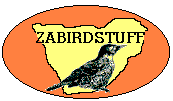 SAfrican
Birding Spots
SAfrican
Birding Spots
Magoebaskloof
The Magoebaskloof area on the drakensberg escarpment in the Northern
Province provides accessible forest birding, particularly in the De Hoek
forest reserve. While the fine indigenous evergreen forests in the De Hoek
and Woodbush Forest is undoubtedly the main attraction, the area has a
variety of habitats including exotic eucalyptus and pine plantations, marshes
and reedbeds, upland grassland and a variety of marginal habitats on forest
and plantation edges.
Birds
The large protected forests contain a wide range of forest species,
including specials such as Blackfronted Bush Shrike, Orange Thrush, Cinnamon
Dove, Longtailed Wagtail, Starred and Chorister Robin, Scalythroated Honeyguide,
Emerald Cuckoo, Knysna Lourie, Narina Trogon, Cape Parrot, Crowned Eagle,
Forest Buzzard, Green Twinspot, Yellowstreaked Bulbul, Barratt's Warbler,
Bluemantled Flycatcher and Grey Cuckooshrike. Sunbirds are well represented
and include Collared and both Lesser and Greater Doublecollared Sunbirds.
The elusive Bat Hawk is known to breed in the area.
Birding
1. Woodbush/De Hoek Forest Reserve
The best birding area is undoubtedly the forest drive. This drive allows
access to a seldom used road which winds down steeply through forest and
patches of exotic plantations. Travelling from Pietersburg on the R71,
pass the little town of Haenertsburg. About 2 km from the Magoebaskloof
Hotel, take the gravel turn to the left to Houtbosdorp. Take the first
right fork to the Woodbush forest reserve which splits before taking you
past a hikers hut. Shortly afterwards a much less-used road veers to the
right. Follow this steep and winding road - listening for the calls of
birds and stopping regularly. Most of the specials can be picked up on
calls. Look out for Bluebilled Firefinch on the road and watch for raptors
and Cape Parrot overhead. In winter and spring, birds are often concentrated
in bird parties, and the calls of Squaretailed Drongo, Grey cuckoo Shrike
or even Cape White-eyes should prompt a stop to locate the bird party and
watch a variety of birds going past. Stop at breaks in the forest which
provide a view across the valley and look for soaring raptors such as Crowned
Eagle and African Goshawk. The entire drive down to the Debengeni Falls
turnoff should take about three hours if you cover it thoroughly, and most
of the specials can be recorded on this drive. The entire route is about
16 km and rejoins the main tarred road some 4 km after Debegeni. Scalythroated
Honeyguide, Emerald Cuckoo, Black-fronted and Olive Bush Shrikes, Narina
Trogon are all best seen with the aid of a tape recorder. Species such
as Grey Cuckoo Shrike, Cape Batis and Barratt's Warbler can be inconspicuous
if you are not familiar with their calls.
2. Marginal Areas.
Forest edges, gardens, farms, exotic plantations and plantation verges
should not be ignored while in the Magoebaskloof area. Although lakes in
the area are not too productive, marshy areas and reedbeds can also be
interesting. A number of species are more easily seen in these marginal
areas. These include Forest Buzzard, Longcrested Eagle, Lazy Cisticola,
Rameron Pigeon, Redbacked Mannikin, Swee Waxbill and Green Twinspot. A
number of forest species also venture into these marginal areas, including
Greater Doublecollared Sunbird, Knysna Lourie and Gymnogene. A good walk
is along the gravel road which turns to the left just below the Magoebaskloof
Lodge, which is several kilometres down the pass from the Magoebaskloof
Hotel. You can leave your car at the lodge and follow this road for as
long as you have time, although a twenty minute stop is often rewarding.
Almost any of the many roads in the area are interesting. Forest Buzzard
is often seen on telephone poles, while Rameron Pigeon seems to like pine
plantations. A good road is the Rooikoppies road. This inconspicuous turnoff
is about 3 km below the junction between the main Magoebaskloof road and
and the De Hoek/Debegeni road described above. The road crosses a stream
where Long-tailed Wagtail, Brownhooded Kingfisher and Redfaced Cisticola
should be looked for. Follow the main road (the one without no entry signs!)
for several km, stopping regularly. Longcrested Eagle and Jackall Buzzard
are present Lazy Cisticola should be looked for near slopes with old felled
plantations.
3. Marshes and Grasslands
Marsh and grassland habitats are found alongside the R528, shortly after
the turnoff from the R71 jsut below Haenertsburg. At present the dam is
very full, flooding an extensive reedbed holding Yellowrumped Widow (summer),
Grassbird and Levaillaint's Cisticola. Nevertherless this is worth a short
stop. Other species present in the area include Redwinged Francolin (grasslands)
and African Rail. African Marsh Harrier, and a range of Warblers can also
be found on the fringes of the Ebenezer Dam.
INFORMATION
Accomodation is available at the Magoebaskloof Hotel, Troutwaters Inn
and Lakeside Chalets (camping too) and Magoebaskloof Lodge (chalets)
Go to Magoebaskloof Checklist
Magoebaskloof Trip List (6-7 September 1997)


Tell
us what you saw and where ! - send a contribution to this guide to Magoebaskloof.
 SAfrican
Birding Spots
SAfrican
Birding Spots